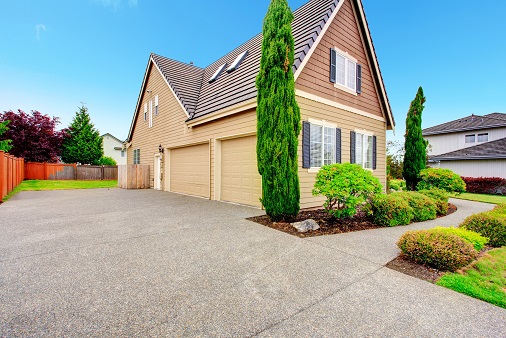Breathable concrete sealers and breathable brick sealers allow the concrete and brick to breathe. While the movement of water and moisture through the pores it reduced, it won’t be stopped, allowing build up vapor pressure to be released through the surface. Brick should only be sealed with a breathable sealer, but in some cases, non-breathable sealers may need to be used on concrete.
When should a breathable sealer be used? A breathable sealer should always be used when sealing exterior concrete and brick. Moisture vapor levels rise and drop depending on the outside weather and temperature. Failing to use a breathable sealer on an exterior application can result in coating failure.
Can a non-breathable sealer be used on brick? Brick should only be sealed with a breathable sealer because brick needs to breathe. Trapping moisture vapor below the surface can not only cause coating failure, but deterioration of the brick from within the pores.
Can a non-breathable sealer be used on concrete? On exterior concrete no, but on interior concrete yes. Some applications require that the moisture be reduced to below a certain for level. For example, if hardwood flooring will be installed, moisture must be below 3 LBS. In this case, a vapor barrier or moisture mitigating epoxy needs to be used.
What are some examples of breathable sealers? All penetrating sealers are breathable, but paint and coatings are not. The level of breathability will vary with some sealers as well, depending on the percent solids. The three most common types of breathable sealers are silicate sealers, silane siloxane sealers, and acrylic sealers.
- Silicate Sealers – Silicate sealers, also known as densifiers, are designed to increase the strength and density of the concrete. They chemically react to form a hardened crystalline barrier within the pores to reduce pore size and increase surface strength. Densifiers are common used to strengthen old, weak, or deteriorating concrete, as well as used as part of the polishing process.
- Silane Siloxane Sealers – Silane Siloxane sealers, also known as water repellent sealers, are designed to reduce surface water absorption and reduce deterioration and staining caused by it. They chemically react below the surface to form a hydrophobic barrier that will cause water and other liquids to bead off the surface. Surfaces sealed with a Silane Siloxane sealer are more resistant to damage caused by water absorption such as cracking, spalling, freeze thaw and ice damage, mold and mildew growth, and efflorescence formation.
- Acrylic Sealers – Acrylic sealers are called sealers, but they classify more as a coating because they leave behind a visible surface film. You can’t tell if a surface has been sealed with a silicate sealer or a silane siloxane sealer, but you can tell if a surface has been sealed with an acrylic sealer because it will have a visible gloss film. Acrylic sealers are considered to be breathable up to 25%, but anything over that level of solids should not be used on porous surfaces or surfaces constantly exposed to water. Acrylic sealers are the least breathable type of sealer, but they are very popular especially if you need to bring out dull or faded surfaces, or want to achieve a level of gloss. If you plan on applying an acrylic sealer to clay brick, you should contact the manufacturer to see if any changes in application should be made.
Breathable Sealer Comparison
| Silicate Sealer | Silane Siloxane Sealer | Acrylic Sealer |
| Won’t change look | Won’t change look | Leaves a gloss coating |
| Penetrates into surface | Penetrates into surface | Bonds to surface |
| Won’t break down | Lasts 7-10 years | Lasts 1-4 years |
| Strengthens surface | Reduces deterioration | Enhances and protects surface |
| Used only on concrete | Used on concrete and masonry | Used on concrete and masonry |
Best Breathable Sealer by Surface Type
| Silicate | Silane Siloxane | Acrylic | |
| Concrete | X | X | X |
| Brick | X | ||
| Pavers | X | X | |
| Slate | X | ||
| Flagstone | X | ||
| Granite | X | ||
| Natural Stone | X |
How To Choose the Best Breathable Sealer
Think about your reason for sealing because that is what will determine which sealer is best for your application. Here are a few examples:
- Old and deteriorating concrete: If your concrete is showing signs of deterioration caused by surface abrasion, such as dusting, and the concrete is fairly dry, you may want to consider a densifier to increase the surface strength of the concrete.
- Cracking, spalling, and pitting caused by water absorption: If you are having issues with cracking, spalling, pitting, mold and mildew, or efflorescence then you may want to consider a water repellent sealer to reduce the absorption of water through the surface.
- Fading concrete or paver surfaces: If you want to enhance dull or faded concrete or pavers, or you want to change the look of the surface, then you may want to consider an acrylic sealer.

